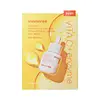Melano CC Intensive Anti-Spot Essence Versus innisfree Vitamin C Green Tea Enzyme Brightening Serum Gel Mask
What's inside
What's inside
 Key Ingredients
Key Ingredients

 Benefits
Benefits

 Concerns
Concerns

No concerns
 Ingredients Side-by-side
Ingredients Side-by-side

Water
Skin ConditioningButylene Glycol
HumectantNiacinamide
SmoothingPropanediol
Solvent1,2-Hexanediol
Skin ConditioningGlyceryl Glucoside
HumectantGlycerin
HumectantErythritol
HumectantCarbomer
Emulsion StabilisingArginine
MaskingHydrogenated Lecithin
Emulsifying3-O-Ethyl Ascorbic Acid
Skin ConditioningCitrus Reticulata Peel Extract
Skin ConditioningXanthan Gum
EmulsifyingAllantoin
Skin ConditioningEthylhexylglycerin
Skin ConditioningPolyglyceryl-10 Laurate
Skin ConditioningGlutathione
Coptis Japonica Root Extract
Skin ConditioningGardenia Florida Fruit Extract
Skin ConditioningSodium Hyaluronate
HumectantSodium Phytate
Dextrin
AbsorbentAscorbyl Tetraisopalmitate
AntioxidantGluconolactone
Skin ConditioningFerulic Acid
AntimicrobialDisodium EDTA
Centella Asiatica Leaf Extract
Skin ConditioningCeramide NP
Skin ConditioningCyclodextrin
AbsorbentBifida Ferment Lysate
Skin ConditioningLactobacillus Ferment Lysate
Skin ConditioningLactococcus Ferment Lysate
Skin ConditioningDipropylene Glycol
HumectantProtease
ExfoliatingPanthenol
Skin ConditioningAsiaticoside
AntioxidantAsiatic Acid
Skin ConditioningMadecassic Acid
Skin ConditioningBeta-Glucan
Skin ConditioningSodium Ascorbyl Phosphate
AntioxidantHyaluronic Acid
HumectantSodium Hyaluronate Crosspolymer
HumectantHydrolyzed Hyaluronic Acid
HumectantHydrolyzed Sodium Hyaluronate
Skin ConditioningHydroxypropyltrimonium Hyaluronate
Potassium Hyaluronate
Skin ConditioningPentylene Glycol
Skin ConditioningSodium Acetylated Hyaluronate
HumectantAscorbic Acid
AntioxidantCyanocobalamin
Skin ConditioningBiotin
AntiseborrhoeicFolic Acid
Skin ConditioningRiboflavin
Cosmetic ColorantPyridoxine
Skin ConditioningThiamine Hcl
MaskingWater, Butylene Glycol, Niacinamide, Propanediol, 1,2-Hexanediol, Glyceryl Glucoside, Glycerin, Erythritol, Carbomer, Arginine, Hydrogenated Lecithin, 3-O-Ethyl Ascorbic Acid, Citrus Reticulata Peel Extract, Xanthan Gum, Allantoin, Ethylhexylglycerin, Polyglyceryl-10 Laurate, Glutathione, Coptis Japonica Root Extract, Gardenia Florida Fruit Extract, Sodium Hyaluronate, Sodium Phytate, Dextrin, Ascorbyl Tetraisopalmitate, Gluconolactone, Ferulic Acid, Disodium EDTA, Centella Asiatica Leaf Extract, Ceramide NP, Cyclodextrin, Bifida Ferment Lysate, Lactobacillus Ferment Lysate, Lactococcus Ferment Lysate, Dipropylene Glycol, Protease, Panthenol, Asiaticoside, Asiatic Acid, Madecassic Acid, Beta-Glucan, Sodium Ascorbyl Phosphate, Hyaluronic Acid, Sodium Hyaluronate Crosspolymer, Hydrolyzed Hyaluronic Acid, Hydrolyzed Sodium Hyaluronate, Hydroxypropyltrimonium Hyaluronate, Potassium Hyaluronate, Pentylene Glycol, Sodium Acetylated Hyaluronate, Ascorbic Acid, Cyanocobalamin, Biotin, Folic Acid, Riboflavin, Pyridoxine, Thiamine Hcl
 Reviews
Reviews

Ingredients Explained
These ingredients are found in both products.
Ingredients higher up in an ingredient list are typically present in a larger amount.
Ascorbic Acid is is pure Vitamin C. This form makes up the largest amount of vitamin C found naturally in our skin.
Not only is vitamin C great for your overall health and immune system, it also has plenty of benefits on your skin.
Vitamin C is best used for brightening skin. It improves dark spots, acne scars, and hyperpigmentation. This is because it blocks the process of skin darkening when exposed to UV.
Remember: Vitamin C should not replace sunscreen!
Your skin uses vitamin C to build collagen. Collagen is one key component in having a strong skin barrier and plump skin. Vitamin C also plays a role in regulating collagen, thus making it effective in improving wrinkles and fine lines.
Ascorbic acid shows potent antioxidant activity. As an antioxidant, it helps fight free-radicals. Free-radicals are molecules that may damage your skin cells. These antioxidants also protect skin against UV damage.
The best formulations include Vitamin E and/or ferulic acid. These two ingredients help stabilize and provide a boost in the benefits of ascorbic acid. This is because ascorbic acid becomes unstable when exposed to UV and air. In fact, you can tell your ascorbic acid has oxidized when it turns an orange-yellow color.
Ascorbic acid is generally compatible with other ingredients. However, using ascorbic acid with other active ingredients might cause irritation. Two ingredients: copper ions and benzoyl peroxide, will inactivate ascorbic acid completely.
Read more about other types of Vitamin C:
Foods rich with vitamin C include oranges, strawberries, broccoli, bell peppers, and more. When consuming Vitamin C, your skin receives a portion of the nutrients.
Learn more about Ascorbic AcidButylene Glycol (or BG) is used within cosmetic products for a few different reasons:
Overall, Butylene Glycol is a safe and well-rounded ingredient that works well with other ingredients.
Though this ingredient works well with most skin types, some people with sensitive skin may experience a reaction such as allergic rashes, closed comedones, or itchiness.
Learn more about Butylene GlycolDisodium EDTA plays a role in making products more stable by aiding other preservatives.
It is a chelating agent, meaning it neutralizes metal ions that may be found in a product.
Disodium EDTA is a salt of edetic acid and is found to be safe in cosmetic ingredients.
Learn more about Disodium EDTAWater. It's the most common cosmetic ingredient of all. You'll usually see it at the top of ingredient lists, meaning that it makes up the largest part of the product.
So why is it so popular? Water most often acts as a solvent - this means that it helps dissolve other ingredients into the formulation.
You'll also recognize water as that liquid we all need to stay alive. If you see this, drink a glass of water. Stay hydrated!
Learn more about Water